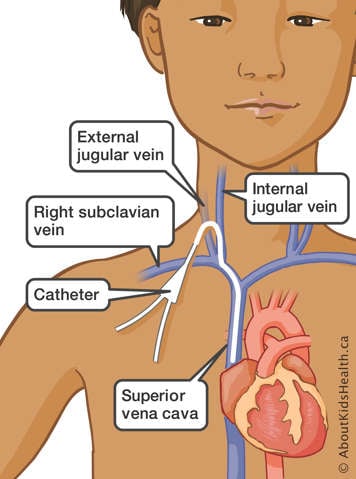To help prepare for your child’s blood and marrow transplant (BMT), your child will receive a double lumen central venous line (CVL). A CVL is a long, soft, thin, flexible tube that is inserted into one of the large veins leading to the heart. It is a special intravenous (IV) line that is used in children who need IV therapy for a long time. IV therapy means medicine that is put into the vein. A CVL makes it easier and more comfortable for your child to receive medicines such as chemotherapy and IV fluids, or to have blood samples taken.
What happens during the procedure?

Your child will have a special "sleep medicine" called a general anaesthetic before the procedure. This will make sure that your child sleeps through the procedure and will not feel any pain.
During the procedure, the doctor threads the CVL tube through a vein in the neck and places it in the large vein leading to the heart, where the blood flow is fast. This placement allows for better mixing of medicines and IV fluids.
It will take about one hour to insert the CVL.
What to expect after the procedure
After the procedure, your child will have two large bandages: one on their neck and one over their chest area. These bandages are sterile. This means that they are put on in a special way to keep the site as germ-free as possible.
The neck dressing is cloth-like and will be removed within a few hours. There will also be a bandage over the CVL exit site on the chest wall. It is normal to see some blood under this bandage. You will see a small stitch in both the neck and chest area. These stitches will dissolve and fall off on their own, usually within a few weeks.
The CVL can be used right away.
For the first day or two after the procedure, some children may feel mild pain or discomfort in the neck or chest. If this happens, ask your nurse or doctor if you can give your child something for pain.
Often, children feel like they have a stiff neck due to the neck bandage. It is safe for your child to move their neck as usual.
Your child will not feel any pain when the CVL is being used.
How to care for the CVL
There must always be a bandage over the CVL site on the chest. This bandage keeps the CVL clean and secure. The end of the catheter tube, called the hub, will be closed with a cap.
While you are in the hospital, the nurses will care for your child’s CVL.
When you go home, a Community Care Nurse will care for your child’s CVL. As you become more comfortable caring for the CVL, the Community Care Nurses will teach you how to provide some of this care yourself.
The CVL will always have either an infusion or a heparin lock. An infusion means that fluids are passed through tubing and a pump. Heparin is a medication that helps prevent the CVL from becoming blocked so that it will work well every time your child needs IV medications or fluids. New heparin will be flushed into the CVL after each use. If it is not being used each day, the heparin flush will be done every 24 hours.
It is always important to keep the CVL dry. If the CVL gets wet, it can become infected. Your nurse will teach you how to cover the CVL to keep it dry when your child bathes. If the bandage gets wet, it should be changed right away.
Protect the CVL
Although the CVL is quite secure, it can come out if it is pulled. It is very important to make sure the CVL is always taped in a looped position and covered with a bandage. For additional security, it may be possible to loop the line under the dressing.
It is also important that the end of the catheter, called the hub, is taped to your child’s chest or tummy to prevent it from being damaged, broken or pulled out by accident. Contact your Community Care Nurse if the CVL comes out a little or is hard to flush.
What to look out for after the CVL insertion
Contact your Community Care Nurse, the Vascular Access Service at the hospital, or your doctor or clinic nurse if your child has:
- fever or chills
- bleeding, redness, or swelling around the CVL or neck
- leaking or drainage at the CVL site
- pain when the CVL is being used
Because each child’s situation is different, you should also ask your doctor if there are any specific instructions for your child.
Activities
After the CVL is inserted, your child will be able to go back to most activities within a day or two as long as they are not experiencing any pain. This includes going to day care or school. Tell your child’s caregivers or teachers about the CVL.
Your child may also be able to play some sports and games such as bike riding and tennis. It is important for your child to maintain as many usual activities as possible. Your child should avoid:
- water sports or swimming. A wet bandage increases the risk of infection. If the bandage becomes wet, it should be changed right away.
- using scissors anywhere near the CVL
- sports that might result in a hit to the CVL or cause the catheter to be pulled out, such as hockey, football, gymnastics, or basketball
- letting other children touch or play with the CVL